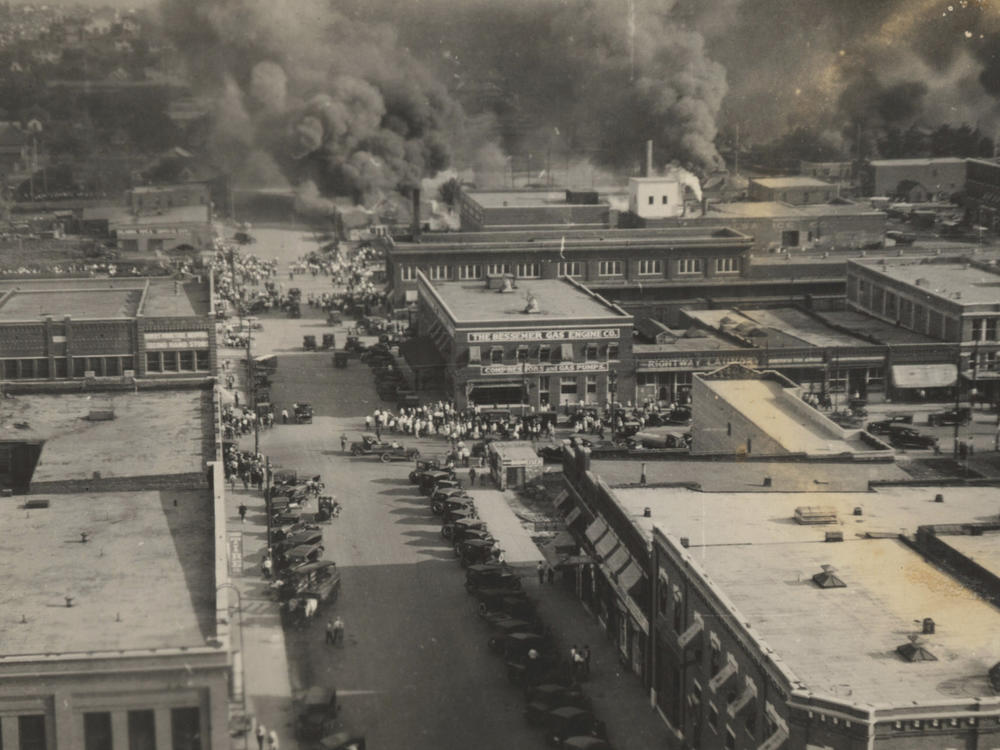Section Branding
Header Content
Code Switch's Recommended Reads About The Tulsa Massacre
Primary Content
On this week's episode of the podcast, we went to Tulsa to report on the 100th anniversary of the 1921 massacre, in which a white mob destroyed a Black neighborhood called Greenwood and killed an estimated 300 people, most of them Black. In addition to our reporting on Tulsa, we wanted to tell you about a few books and articles about the massacre that will allow you to take a deeper dive — including some recommendations from a bookstore owner from Tulsa.
From us:
Tulsa 1921: Reporting a Massacre by Randy Krehbiel
A veteran reporter for the Tulsa World for more than four decades, Krehbiel writes about the racial tensions in 1921 Tulsa leading up to the massacre, the part local papers (including his own) played in feeding the resentment and fears of the city's whites, and how city leaders were complicit in covering up the atrocity they knew would stain their metropolis forever. Krehbiel shows how all this contributed to the racial inequities still in Tulsa today, and points out how these unresolved issues make efforts at reconciliation challenging.
The Ground Breaking: An American City and Its Search for Justice by Scott Ellsworth
Ellsworth, a University of Michigan historian, has previously written about the Tulsa Race Massacre in his 1982 book, Death in a Promised Land. (It's now reprinted in paperback.) In The Ground Breaking, he has crafted a stunning narrative that starts with Greenwood at the height of its prosperity, then moves on to the horror of the massacre, and continues to describe the decades-long attempt by some committed Tulsans and their allies to discover the mass graves containing the scores of the massacre's victims' bodies.
Unspeakable: The Tulsa Race Massacre by Carol Boston Weatherford and Floyd Cooper
Writer Carol Boston Weatherford tells the story of Greenwood when it flourished and when it was destroyed, in simple language that tells the truth for young readers. Illustrator Floyd Cooper's gorgeous pictures draw the reader in, and help us to understand the magnitude of the community that was lost when Greenwood was torched by a riotous mob. (And Cooper has a personal connection to Greenwood: His grandfather, a massacre survivor, first told him the story.)
Magic City by Jewell Parker Rhodes
Tulsa in the 1920s was often called "the oil capital of the world" and "Magic City." Parker Rhodes chose to tell the massacre's story through fictionalized characters: the girl who ran the elevators in a ritzy Tulsa department store, and the young Black man who was falsely accused of sexually assaulting her. That assault rumor was the excuse to spark white Tulsa's mass indignation. The outrage was its stated justification for the carnage that followed. The author's deep compassion for almost everyone — including some white Tulsans who were trying to do the right thing — makes for compelling reading. Parker Rhodes' book was first published in 1997 after a press that had committed to it backed out; it's been republished by a new house in time for the centennial.
From Tulsa resident Onikah Asamoa-Caesar, owner of Fulton Street Coffee and Books:
The Victory of Greenwood by Carlos Moreno: A Tulsa local, Moreno has written an anthology that contains several profiles of Black Greenwood entrepreneurs. It also contains a narrative of the Greenwood citizens who came together to rebuild the neighborhood, including a profile of the attorney who sued to remove the legal barriers the city had enacted to impede rebuilding Black Wall Street.
An Impulse to Keep by the Greenwood Art Project: A collaboration of artists, activists, civic leaders, Tulsa residents and others to raise awareness of 1920s Greenwood through art. The 28 art projects are accompanied by essays by nationally and internationally-known writers and seek, overall, to draw all Tulsans together in an effort to promote racial healing.
Opal's Greenwood Oasis by Najah Amatullah-Hylton and Qurash Ali-Lansana and illustrated by Skip Hill. Young Opal Brown takes the reader on a tour of pre-massacre Greenwood, a place where everybody knows everybody else and "everybody looks like me." We know that the safety, security and sense of belonging Opal feels will soon be shattered by one of America's worst racial atrocities, but before that happens, we get to see Greenwood as the vibrant, affluent community it once was. Hill captures Greenwood in collages of photos, paintings and drawings.
Beyond books:
A team at The New York Times has made a terrific interactive feature that takes readers into pre-massacre Greenwood, and identifies all the offices, businesses and other buildings that made up this bustling community. Just scroll and click to see how much was available to Greenwood residents.
NPR visits one family of massacre descendants to learn about their determination that Greenwood history not be erased.
The Washington Post looks at the growing movement for reparations for Greenwood residents, even as much of the original neighborhood is in danger of disappearing thanks to encroaching gentrification.
The Black Wall Street Times writes about state Republicans' effort to keep any mention of white supremacy from being mentioned in the state's public schools by banning Critical Race Theory from being taught K-12.
Copyright 2021 NPR. To see more, visit https://www.npr.org.

